Menu
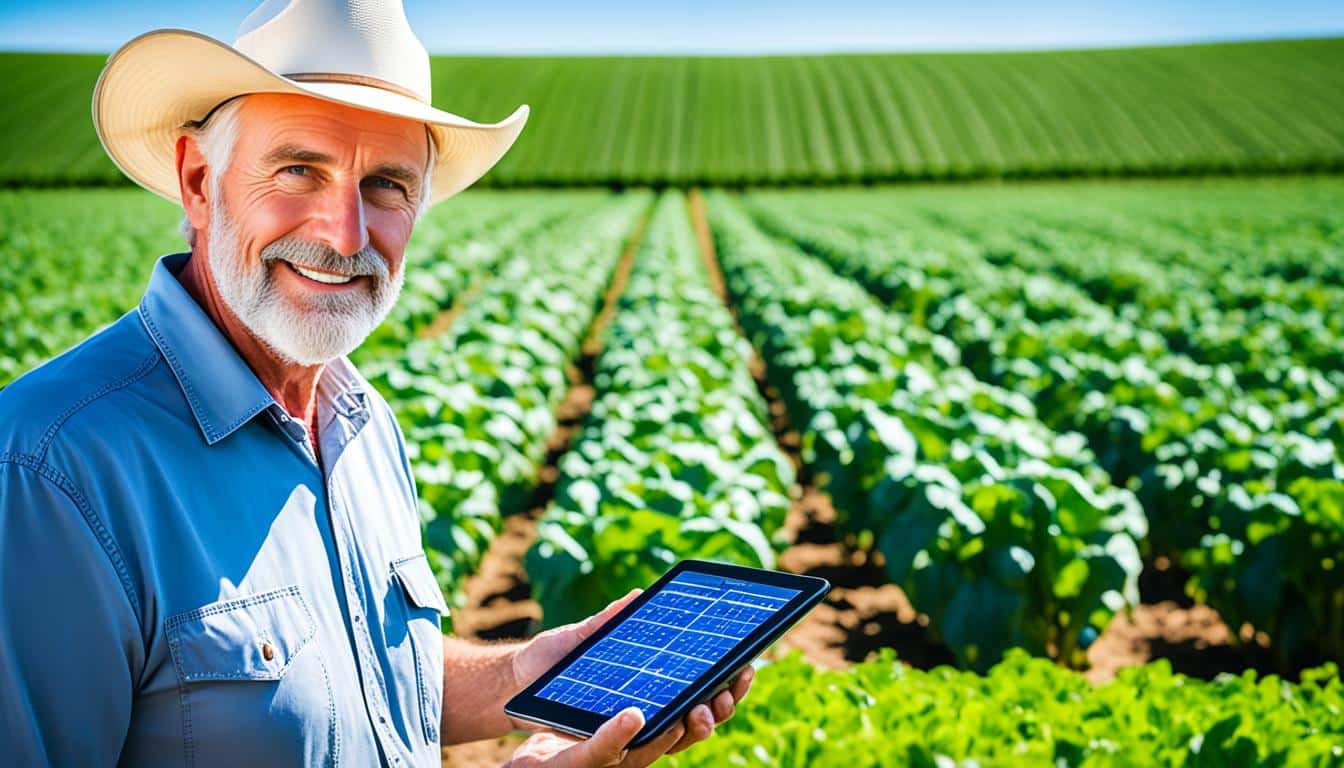
“Agriculture is the most healthful, most useful, and most noble employment of man.” – George Washington
We know that farmers aim to produce more crops while spending less money. To succeed, they carefully plan and customise their approach. We look into key strategies for maximising crop yield. This includes using precision agriculture, monitoring the health of the soil, choosing the right seeds, managing pests, watering crops well, using fertilisers wisely, growing a variety of crops, and exploring different farming techniques.
Applying these strategies thoughtfully can boost both profit and environmental sustainability. For instance, precision agriculture uses technology and data to make farming more efficient. Picking the best seeds greatly affects how much crop a farm can produce. Integrated pest management helps keep crops healthy without using too many chemicals. Efficiently watering crops saves time, money, and supports a greener farm.
A crop management plan is key to boosting farming. Picking the right crops for your farm’s soil and weather is crucial. This can help grow more crops.
To manage crops well, knowing your soil is vital. The way you till the land matters a lot. Regular tilling can harm the soil by speeding up its breakdown. But if you till less or not at all, the ground keeps more nutrients. This makes the soil and crops healthier.
Getting watering and feeding right is also important. Sowing seeds at the correct depth makes sure they get enough water. This boosts how many seeds actually sprout. Using water wisely is key, with drip systems being better than floods.
When it comes to feeding your crops, tests should guide you. These checks make sure your plants get what they need without overdoing it. Too much feeding can hurt the environment.
Looking after pests is a must. Methods like using different kinds of crops can help control pests without much chemical use. This can lower the chances of crop problems and actually make the soil better.
Knowing the best time to harvest is important. Cutting crops at their peak stops you losing too much. For instance, alfalfa is best cut before it fully blooms. And keeping cereals at the right moisture level stops them from spoiling.
Modern tech lets farmers schedule planting very accurately. This isn’t just good for saving resources. It also helps grow more crops. Using technology also helps predict how many crops you’ll get. This helps farmers plan their budget and work better.
A good crop management plan covers everything from picking crops to using advanced tools. This all helps get more crops while looking after the land well.
The key to a good harvest is choosing the right seeds. This choice has a big impact on how your crops do and how much you grow. It’s important to look at a few things like the local weather, the seed’s quality, and its ability to resist diseases. A smart choice in seeds can make a farm more productive and last for many years.
Knowing your area’s climate is vital in seed picking. Some seeds do well in certain weather. For example, you’d pick seeds that can handle little water in dry places or seeds that love rain in wet spots. Tools like the WinField® United Characterization Charts are great for seeing what seeds work where. Also, getting advice from local experts and using their data, like from the WinField Answer Plot®, can help you choose wisely.
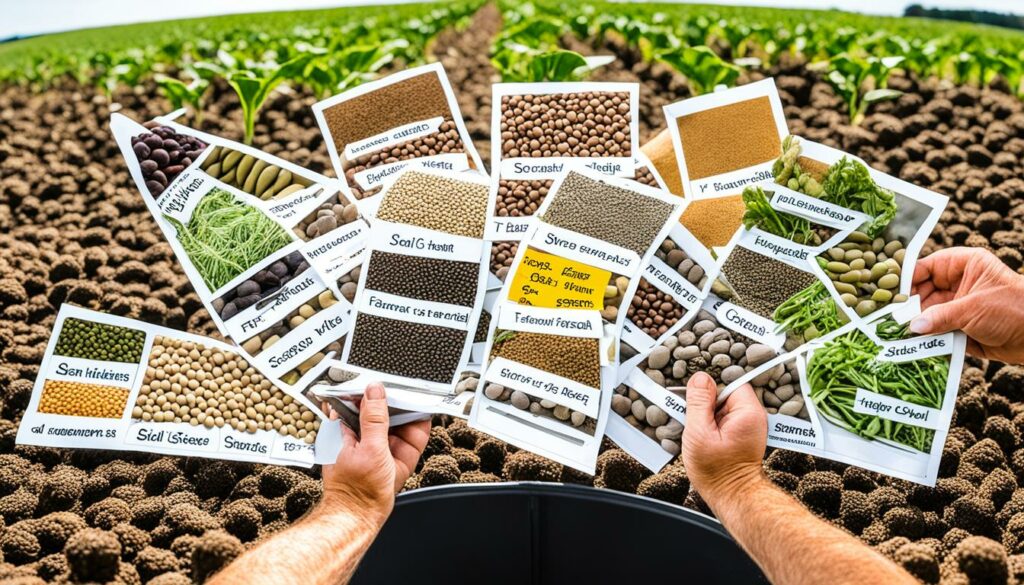
It’s crucial to use top-notch seeds for a healthy harvest. These seeds grow into strong plants that can handle tough conditions. Picking seeds that aren’t prone to diseases means you don’t need as many chemical treatments. This helps the environment and your farm’s long-term health. Disease-resistant seeds lead to healthier crops and bigger harvests. So, investing in quality, disease-resistant seeds pays off in many ways.
Here’s why picking the right seeds is so important:
| Benefit | Description |
|---|---|
| Disease Resistance | Minimises chemical treatments and ensures plant health |
| Nutrient Management | Optimises yield potential with tailored fertilisation and nitrogen management |
| Environmental Compatibility | Aligns with local climate conditions for better growth |
| Yield Optimisation | Enhances economic returns through robust harvests |
Picking seeds with care, relying on data and advice, is the foundation of farming success. This method boosts yields from the start and keeps your farm strong and sustainable over time.
Precision agriculture is leading the way in modern farming with its use of technology and data. It increases efficiency and yield. It focuses on using resources better for sustainable farming. Two key areas are GPS systems and sensor technology.
GPS systems are critical in precision agriculture. They help make detailed field maps and track where machinery goes. They also help apply things like seeds and pesticides accurately. This cuts down on waste and makes sure resources are used well. It means better crops and less harm to the environment.
Drones and sensors are changing farming too. Drones take pictures of crops, check the soil, and look for pests. This info helps farmers decide how to water, fertilise, and control pests. Soil sensors also give real-time data about the soil, which helps with specific watering and fertilising plans.
Bringing together these technologies helps farming be more sustainable. It also makes farming more efficient and productive. Precision agriculture is the future of farming, blending old practices with new technology. It creates a farming future that’s both successful and kind to the planet.
| Application Areas | Technology Involved | Benefits |
|---|---|---|
| Soil Nutrient Management | IoT, Sensors | Optimised fertilisation, enhanced soil health |
| Seed Drill Depth Control | GPS, Automation | Accurate seed placement, improved germination rates |
| Precision Seeding Devices | GPS, Variable Rate Technology (VRT) | Efficient seed usage, increased yield |
| Smart Irrigation Systems | IoT, Meteo-Hydrological Modelling | Water conservation, increased crop yield |
| Autonomous Spraying Robots | IoT, Machine Learning | Reduced pesticide use, precise application |
Maintaining soil health is key to sustainable farming. We must check soil health and use the right methods to keep it fertile and productive for years.
Checking soil health often is vital. We look at its physical, chemical, and life aspects. This includes things like soil feel, water-holding, pH, and the life in it.
This testing helps us make smart decisions. It means we can give the soil what it needs. This can be through crop rotation or using good fertilizers.
Using cover crops is a great soil health tactic. These are plants not meant to harvest directly. They are there to cover the soil. This practice helps soil structure, lowers erosion, adds biodiversity, and boosts fertility by pulling nitrogen from the air.
Additionally, making biochar from leftover plants can clean the soil. It also adds to the soil’s goodness, helping plants grow better.
Crop rotation means planting different crops one after the other. It stops the soil from getting tired. It also makes it less likely for pests and diseases to grow. By changing what grows, we keep the soil healthy and strong.
There’s also a method called bioremediation. This can help the soil heal from drought or pollution. It’s another way to make the soil more resilient.
| Soil Management Practice | Benefits |
|---|---|
| Regular Soil Testing | Informs nutrient management, enhances crop yields |
| Cover Cropping | Improves soil structure, reduces erosion, enhances fertility |
| Crop Rotation | Prevents soil depletion, reduces pests and diseases |
By testing the soil often and using cover crops and rotation, we help crops thrive. This not only benefits us now but also keeps the land healthy for those who come after us.
Integrated pest management (IPM) helps in farming without harming the environment. It uses natural ways and cuts down on harmful chemicals. This makes crops and the environment healthier. Now, let’s look at some important parts of IPM.
IPM focuses on the natural enemies of pests. Farmers encourage helpful insects and animals. For example, ladybirds eat aphids and spiders catch other bugs. This means they use less chemical sprays, which is good for the planet. It also helps keep the ecosystem in balance.
Biopesticides are also key in IPM. They come from plants, bacteria, and minerals. These are a safer choice than common pesticides. Biopesticides help fight pests without hurting the soil or other living things. Using them supports sustainable farming, protecting the environment and those who work on farms.
IPM involves looking at the whole pest situation and taking steps before pests become a big problem. By using friendly bugs and safe chemicals, farmers can better control pests. This lets them grow more food without the downsides of heavy pesticide use.
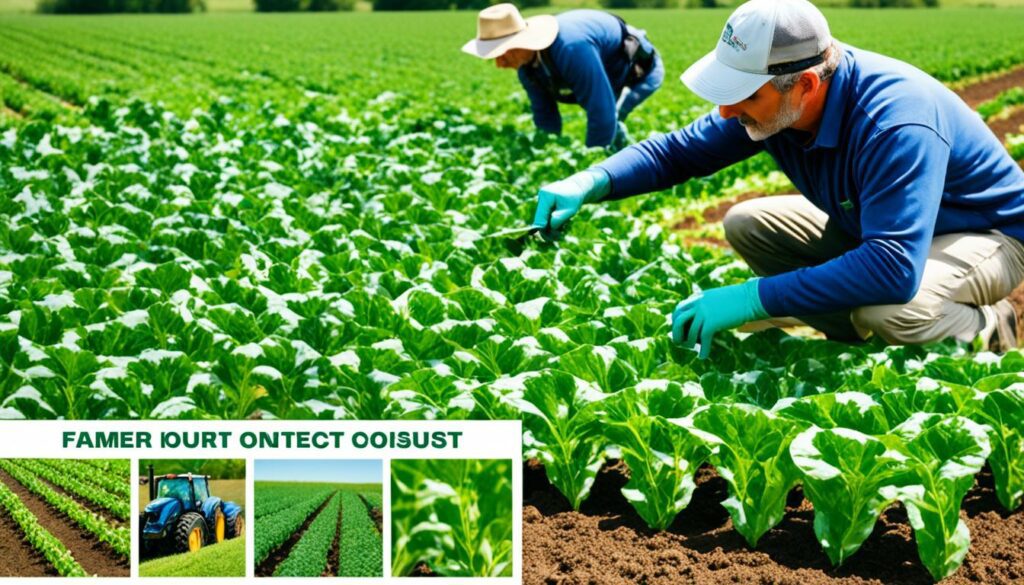
| Pest Control Method | Description | Benefits |
|---|---|---|
| Natural Predators | Use of beneficial insects and animals to control pest populations. | Reduces chemical use, promotes ecosystem balance. |
| Biopesticides | Natural substances derived from plants, bacteria, or minerals to manage pests. | Eco-friendly, minimises soil and water pollution. |
Effective irrigation management is key for using water sustainably and achieving the best crop yields. Our efforts to improve irrigation practices help farms produce more food. This, in turn, saves water, which is vital for lasting farming.
Drip irrigation greatly boosts how efficiently water is used, sometimes by half compared to older ways. It waters plants right at their roots. This cuts down on water lost to the air and saves more for the crops. For instance, in China’s Huang-Huai-Hai Plain, a switch to drip caused a 29% water drop. At the same time, it raised the water’s impact on crops by over 90%, compared to flooding. These methods also reduce water running off, making sure more soaks into the soil for plants to use.
Getting crop water needs right is vital for smarter irrigation. New tech lets farmers use 20-30% less water but get 10-20% better crops. It’s about tools like Variable Rate Irrigation with GPS. They water fields precisely, matching what each spot needs. This is not only water-wise but also good for the land in the long run.
Methods like mulching and cover crops can also keep water in the ground, cutting irrigation needs by half. Also, checking water quality often helps make irrigation even better. This can lower water costs by 10-15%. By looking at how much water we use and how good it is, we make sure our fields thrive for a long time.
Nutrient management is key to getting the best crop yields. By carefully handling soil nutrients, we make sure our crops grow well. This also helps protect the environment and saves money on unnecessary fertilisers.
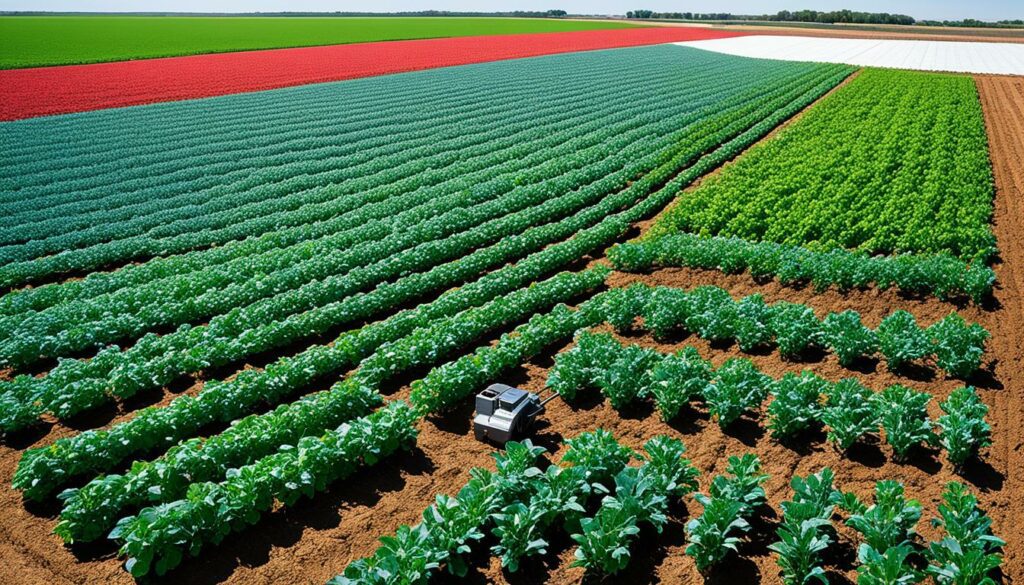
Knowing about soil nutrients is at the heart of good nutrient management. Tests on soil tell us what’s in it, like nitrogen and phosphorus. This helps us use the right amount of fertiliser for the crops, stopping it from causing pollution.
In sub-Saharan Africa, there’s been a growing lack of nitrogen in the soil over years. Meanwhile, places like China and the USA have used more nitrogen. This shows the huge differences in how nutrients are managed around the world.
Smart use of fertilisers is vital for farming that can last. We follow expert advice on which fertiliser to use and when, making sure crops take in the nutrients. Technology like VRT helps us apply fertilisers more precisely, saving money and protecting the environment.
In Southern Benin, the right amount of fertilisers for crops is known. But, the actual amount used in that country is much lower, showing a need for better practices.
| Region | Recommended N (kg ha−1 yr−1) | Current N (kg ha−1 yr−1) | Recommended P (kg ha−1 yr−1) | Current P (kg ha−1 yr−1) | Recommended K (kg ha−1 yr−1) | Current K (kg ha−1 yr−1) |
|---|---|---|---|---|---|---|
| Southern Benin | 60 | 2.3 | 17 | 0.5 | 0 | 1.1 |
| Northern Nigeria | 120 | 1.5 | 26 | 0.2 | 50 | 0.3 |
It’s important to know how much nitrogen crops can actually use. For maize, rice, and wheat, this can be from 10% to 52%. In Europe, between 6% and 43% of nitrogen fertiliser gets used by the crops. These numbers stress how essential it is to manage nutrients well.
By looking after nutrients in soils carefully, we can make farming better for the economy and the planet.
Crop diversification is key to sustainable farming, especially with growing world demands and unpredictable climates. As the global population increases by 50% and we see a doubling in grain needs by 2050, we need to focus on methods that boost productivity and protect the planet.
This strategy helps with soil and pest problems and makes farms tougher against market changes and extreme weather. Key actions include growing different crops together, switching what you plant, and adding cover crops to fields.
Intercropping is a smart way to make the most of land and water. By planting several crops together, farmers can use resources better and cut down on the risks from growing just one type. This method has a proven track record of increasing production. For example, in the North China Plain, mixing crops has shown to boost yields by up to 38% compared to growing one crop alone.
Swapping crops is also important for diverse farming. It’s good for the soil and helps lower the amount of greenhouse gases released. Adding beans and other legumes to the mix not just improves the soil but cuts harmful gas emissions by 39%. These changes also make the soil healthier overall, with a 45% boost in its quality.
Cover crops can do wonders for the soil, making it richer and more stable. They also protect against soil loss, pests, and harm to the environment. In places like South Asia, turning to these special crops has increased income and food variety over the past 30 years. Using cover crops is a great way to keep farming fruitful for the long haul.
Looking ahead to feeding more people, strategies like diversification, intercropping, and rotating crops are vital. They preserve soil, raise harvests, and make farming last, supporting our goals for productive and resilient agriculture in the face of climate challenges.
It’s key for farming today to look into alternative farming methods. Techniques like hydroponics and aquaponics can help reduce risks farm face, like bad weather and pests. They create perfect settings for growing that save water and make the most of crops.
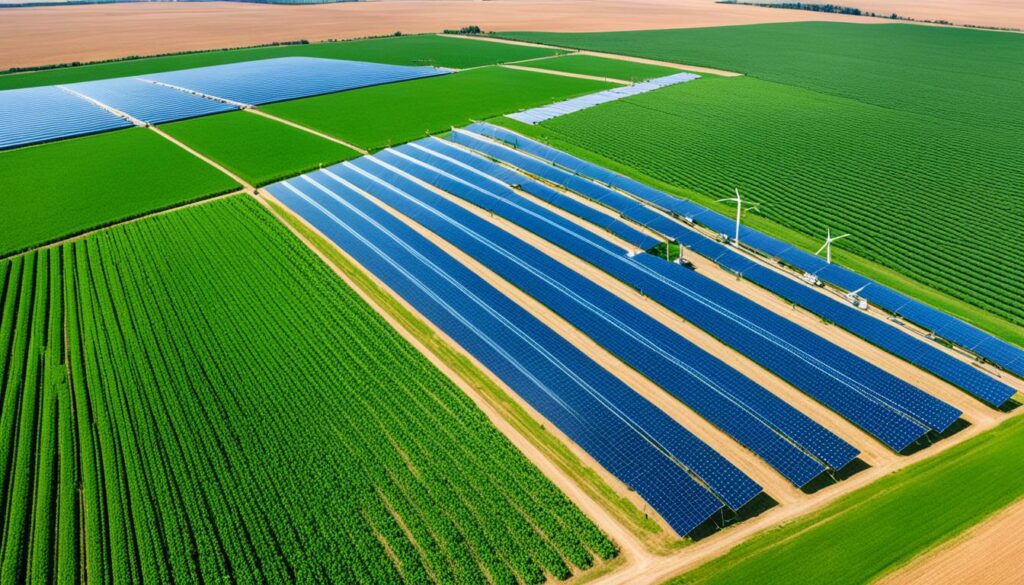
Hydroponics grows plants in water, not soil, with special nutrient mixes. It gives farmers strict control over how plants grow, which leads to more food of better quality. This is amazing for areas with bad soil or not much space for farming, allowing for crops to be grown all year.
Aquaponics is a mix of hydroponics and fish farming. It creates a supportive cycle where fish waste feeds the plants, and the plants clean the water for the fish. This method boosts how well we use resources, cutting down on water waste and the need for harmful chemicals.
The National Mission on Sustainable Agriculture (NMSA) in India focuses on using water and nutrients wisely. It also pushes for farmers to have various income sources. Alternative methods like hydroponics and aquaponics help reach these aims. This way, they can make a better living while looking after the earth and its water and land.
Here’s a quick look at how hydroponics and aquaponics compare:
| Method | Key Features | Benefits |
|---|---|---|
| Hydroponics | Soilless growing, controlled nutrient delivery | Optimised yields, resource efficiency, year-round production |
| Aquaponics | Integration of aquaculture and hydroponics | Sustainable resource use, water purification, enhanced productivity |
Farmers using hydroponics and aquaponics are a part of creating a greener future. These methods help grow more food while taking care of the environment. They fit well with the big idea of sustainable farming.
In the 21st century, technology has changed how farming works. We now use farm management software and remote sensing in agriculture to increase crop yields. These tools help farmers work smarter and use resources wisely.
Modern farmers rely on farm management software. This software uses data analysis and machine learning to keep track of soil, weather, and crop stages. It helps farmers plan effectively and make quick decisions to boost their harvests.
Remote sensing in agriculture is a big step forward in monitoring plants’ health. Thanks to satellite images and special techniques, we can check on crop conditions with high precision. This technology has even helped in places like Uttar Pradesh and Punjab, where it predicts wheat yields accurately. This helps farmers plan better and manage their resources well.
| Technology | Benefits | Application |
|---|---|---|
| Farm Management Software | Enhanced data-driven decision-making | Tracks soil health, weather patterns, crop stages |
| Remote Sensing Tools | Accurate monitoring and yield prediction | Satellite imagery, spectral techniques |
| Precision Agriculture | Resource efficiency | IoT, GPS, drones |
Technology in farming does more than just look at fields. It uses machine learning algorithms to understand satellite data, which helps determine crop health. Plus, with remote sensing and semi-physical models, we can get up-to-date information. But, these methods might not capture every environmental condition.
In India, farming is hugely important, making up almost 20% of the GDP and employing many people. Innovations in technology are key to facing climate change and the growing population. They help make farming sustainable and profitable.
Looking at crops in the middle of their growing season is crucial. It helps spot any problems early and make the most of their potential. Farmers watch how plants are growing and check their health. This lets them fix any issues fast.
Figuring out how crops are growing is key. Knowing this helps manage them better. We use special crop simulation models to guess how they’ll grow. These models are based on things like soil, weather, and how the crops are taken care of. They can give very exact results or just a guess if things are uncertain.
Models based on past data show us general trends in harvests over time. But, they might not show what will really happen in different places. Models that copy how plants grow, like how they use sunlight to grow, need a lot of details to be accurate.
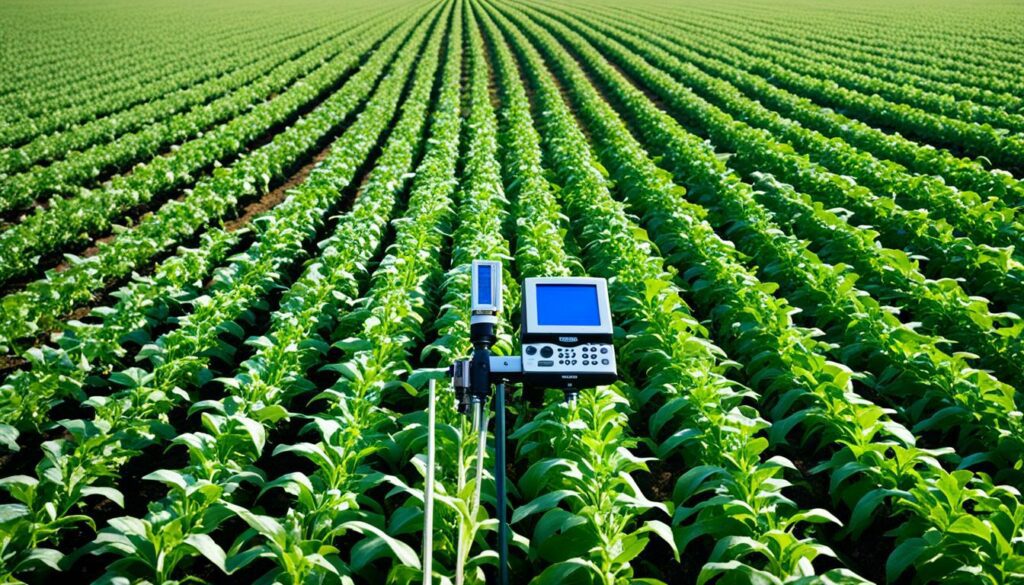
Studies in the US looked at crops from 2000 to 2018. They found a strong link between how much plants were growing and how good the harvest was. As crops grew, these connections got stronger. This info came from precise weekly measures at a 1-km level.
Watching a crop’s canopy tells a lot. It shows how big and healthy the crop is overall. A tool called the Normalized Difference Vegetation Index (NDVI) helps us understand how different weather affects crops. It shows that cereals can withstand drought better than legumes, which is good to know.
| Factors | Frequency | Optimal Correlation | t
|---|---|---|
| Soil Moisture | Continuous (Daily) | Higher in Drier Regions (0.4-0.9) | t
| GPP Anomalies | Weekly | Increasing with Crop Development | t
| NDVI | Periodic (Seasonal) | Impact Analysis | t
By using these tools, we can manage crops better in mid-season. Mixing data from satellites with plant growth models makes things very accurate. This leads to smarter choices and actions to improve harvests.
Mastering stress management is key for sustainable agriculture. It’s vital to tackle both biotic and abiotic stresses. These can greatly affect how well crops grow and how they bounce back from tough times. The stresses include things like soil saltiness, drought, strong winds, extreme temperatures, heavy metals, and invasions by harmful pathogens. With our world’s population set to reach 9 billion by 2050, adapting to these stresses is more important than ever.
Knowing about the different stresses that can affect crops is the first step. Changes in climate, like droughts and too much water, can reduce the food we grow globally. Extreme heat and salt in the soil can make it hard for plants to drink water and do photosynthesis well. These factors cause 84% of problems for crops, with too little water being the biggest issue. A lack of nutrients, which three out of four farmers face, also makes plants weaker and lowers their output.
Growing plants that are tough against harsh conditions is crucial. Picking these kinds of crops helps keep harvests going strong, even in tough times. Today, nearly 80% of farmers are choosing such hardy varieties. This step supports the effort to adapt to environmental stress, helping plants grow undeterred. With such actions, we protect our harvests and work towards a more sustainable future in farming.
Getting harvest planning and preparation right is key to a successful harvest. Farmers need to focus on several important areas to make their harvest better. This can reduce losses after the harvest.
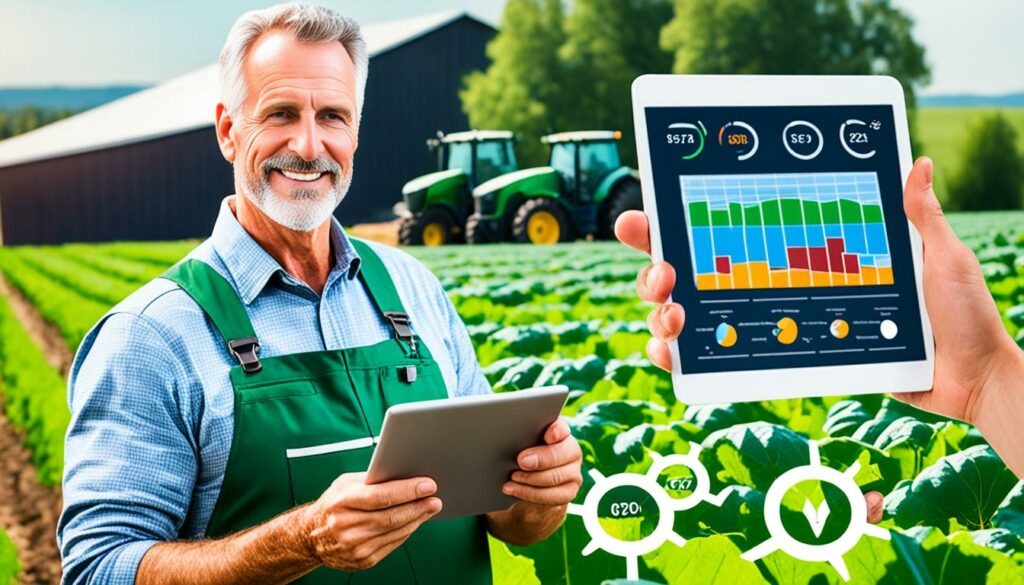
Evaluating crop maturity is a big part of harvest planning. In Arkansas, they expect to produce 980,000 fewer cotton bales this year, a 23% drop. Lint yield should average 1,161 pounds an acre, down by 18 pounds from the last year. It’s vital to check crops carefully to pick the best harvest time. In Arizona, when about 60% of bolls open, they start with defoliants. At 80% open bolls, they use desiccants. Knowing the right time to harvest helps lessen losses, ensuring good quality.
Harvest preparation also means getting all the needed equipment ready. In Arkansas, cotton producers are working on 120,000 fewer acres than before. This makes having efficient machinery very important. All the machinery must be checked, set right, and kept in good shape. This means looking for faults, setting the right levels on harvesters, and making sure vehicles move quickly from the fields to storage.
Harvest planning means checking crop maturity and making sure all equipment is ready. Doing all this means a better harvest, less loss, and better quality produce.
Enhancing post-harvest efficiency is crucial for keeping crop quality high and making more money. By looking at how we store crops and the way we handle them after harvest, we can make our crops last longer and stay fresh.
Making storage spaces better helps keep crops fresh for longer. The right climate and humidity in storage areas stop food from going bad. Tools like climate control and humidity monitors help make sure crops are in the best conditions.
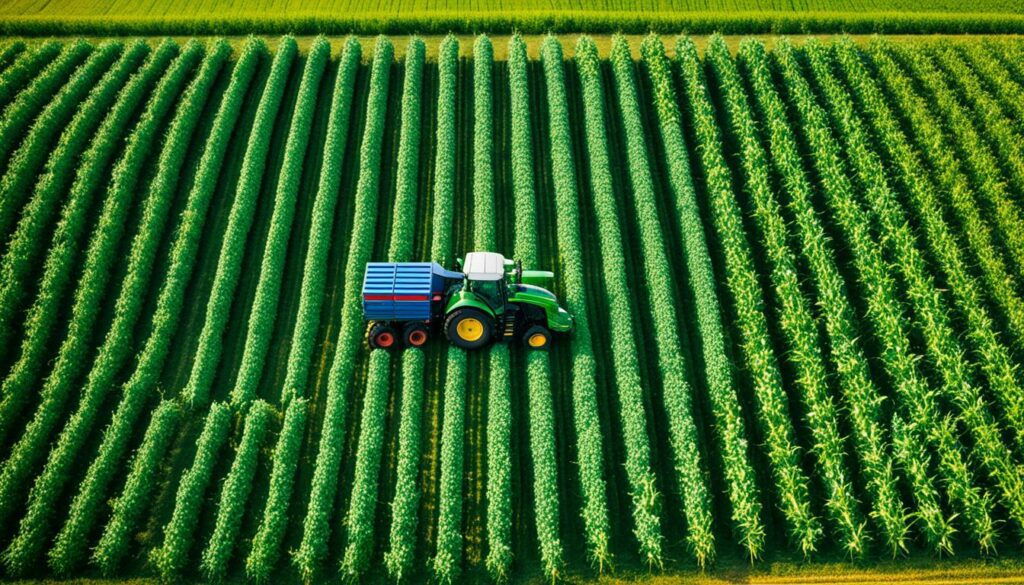
It’s vital to handle crops well after picking to keep them from getting damaged. Using careful tools to pick them and less moving around reduces harm. It also helps to use the right ways to keep each type of crop fresh. Doing this makes sure the crops stay in good shape and are ready to sell.
If we improve how well we predict the amount of crop we’ll have by just 1%, we can make a lot more money and avoid wasting resources. We’ll also make the market more stable and help make sure there’s enough food for everyone. This kind of good prediction lets companies sell more seeds because they know exactly what their customers need, helping to keep the food supply strong.
Vertical farming is an innovative technique in agriculture. It prioritises sustainable and controlled environments. By using structures that stack crops vertically, it can produce up to ten times more. This is compared to traditional farming methods, helping address space limits and boost food production.Automated solutions in farming take this further. They integrate technology for the best efficiency.
Vertical farming keeps crop quality consistent with its controlled growing conditions. It manages temperature, humidity, and light precisely. This leads to higher crop yields and allows for production all year round. Thus, it increases revenue and conserves resources.
Tasks like seeding and watering are automated, cutting down on human work. Indoor farming with this technology uses much less water than traditional ways. This makes it highly sustainable.
Robotics are crucial in vertical farming. They cut back on the need for manual work and improve accuracy in tasks. This includes seeding, harvesting, and packaging.By mixing robotic solutions with IoT devices, farmers can monitor environments constantly. They make smart, data-driven choices to improve farming. As the world looks to reduce greenhouse gas emissions, vertical farming with robotics offers a greener path forward.
Though vertical farming with automation seems very positive, it does have challenges. This includes high initial costs and a need for constant maintenance. But, the market for vertical farming is growing fast. It is projected to grow from 5.5 billion USD in 2020 to about 20 billion USD by 2026. This shows its increasing importance. Also, with support from governments and new initiatives, the mix of vertical farming and automation is key in agriculture today.
Modern farming focuses on both getting better crop yields and being green. Using sustainable farming methods helps do this without harming the planet. It’s about making sure our farming is just as good for the earth as it is for our crops.
Sustainable farming aims to use less that hurts our planet. It uses smart technologies like AI in farming to watch for problems early and solve them without harming nature. For example, drones, satellites, and special sensors can tell us early if plants are sick or if pests are around. This helps us act fast to fix the problem, often without using lots of harmful chemicals.
Going organic is a big help too. It means farming without the harmful stuff. Organic farming doesn’t just give us safe food, it also keeps our soil and water clean. And it helps the plants and animals that make up our ecosystems thrive. This way of farming is all about working with nature, not against it.
Making the best use of resources is key in sustainable farming. It’s especially true for water, where farms use most of what we take from the earth. With help from AI and machine learning, farms can use water, pesticides, and fertilizers smarter. This means growing plenty of food but with less waste. And using less ends up helping our planet more.
Other smart ways to manage resources include things like changing what crops are planted where each year. This keeps the soil rich and healthy while making sure bugs and diseases don’t ruin our harvests. Another good practice is planting extra crops that aren’t meant for eating. These crops cover the soil and make it better. They also help keep water in the ground, which is good for the environment.
| Technique | Benefit |
|---|---|
| AI-Powered Crop Monitoring | Early detection of agricultural changes |
| Organic Farming | Reduces pollution, mitigates GHG emissions |
| Crop Rotation | Prevents nutrient depletion, supports soil fertility |
| Cover Cropping | Improves soil health and water retention |
Combining these methods makes sure farming keeps getting better while protecting our planet. It’s how we make sure growing food also grows a healthy earth.
In ending our look at maximizing crop yields, it’s clear a mix of old and new practices is key. With the world population expected to hit 9.7 billion by 2050, boosting crop growth is critical. This means finding ways to farm better and increase how much we harvest.
Climate change has already caused a 21% drop in farm output since 1961. To tackle this, we must make photosynthesis more efficient. Crops today only turn 2% to 3% of sunlight into plant matter. This poor conversion rate means we have to find ways to grow more, given limited resources like light and nutrients.
Fighting crop losses is vital. Weeds alone cause almost half of all lost crops in places such as India. This is more than what pests do. Using more nitrogen fertiliser can help. It boosts a type of carbon that plants need, making them grow better, especially with more CO2 around. Putting nitrogen-fixing bacteria in crops, like rice, is also showing good results.
New tech, like CRISPR/CAS, is changing how we can adjust crop genetics to help them cope with tough conditions. Bacteria living inside plants have been found to increase harvests, clean up pollutants, and add more nitrogen to the soil. This shows the big role of science and adapting to local farms to keep agriculture growing.
Crop yield optimization helps get the most out of farmland and reduce costs. It’s vital for food security, farmer profits, and sustainable farming.
It selects the best crops, considers the land and weather, and designs irrigation and fertilisation methods. This approach boosts yields and makes farming more efficient.
Farmers look at the local climate before choosing seeds. They should pick seeds that match the area’s rainfall. Quality, disease-resistant seeds can also help a lot.
Precision agriculture uses high-tech tools to use resources better and increase yields. GPS and drones help by providing detailed information.
Checking the soil, covering it, and rotating crops keeps it healthy. This helps crops grow well and supports the future of farming.
Integrated pest management uses natural enemies and eco-friendly pesticides. This lessens the need for harmful chemicals, helping the environment and farms.
Drip irrigation and careful water assessment save a lot of water. They also help manage costs and boost yields.
Looking after soil nutrients and using the right fertilisers keeps crops healthy. This stops environmental damage and cuts down on costs.
Growing different crops reduces risks and improves soil. It also brings in more money. Farmers can adapt better to market and climate changes.
Hydroponics and aquaponics grow crops in controlled, indoor settings. They use less water and prevent pests, leading to more food.
Farm software and remote tools give farmers key information. This helps them manage resources better and improve their harvests.
Checking on crops during the season shows early warnings of problems. Fixing issues early can help achieve the best harvest.
Choosing crops that can handle tough times helps maintain farm output. Being flexible in farming methods is key to long-lasting success.
Harvest planning looks at when crops are ready and getting machinery set. This ensures a fast and loss-free harvest.
By storing and handling crops well after harvest, their quality lasts longer. Good management means more profit and better food for us.
Vertical farming grows food in small, controlled spaces. Automation makes farming more efficient and changes how we grow crops.
By using less water and fewer chemicals, sustainable farming is good for the earth. It also helps farms last for generations.